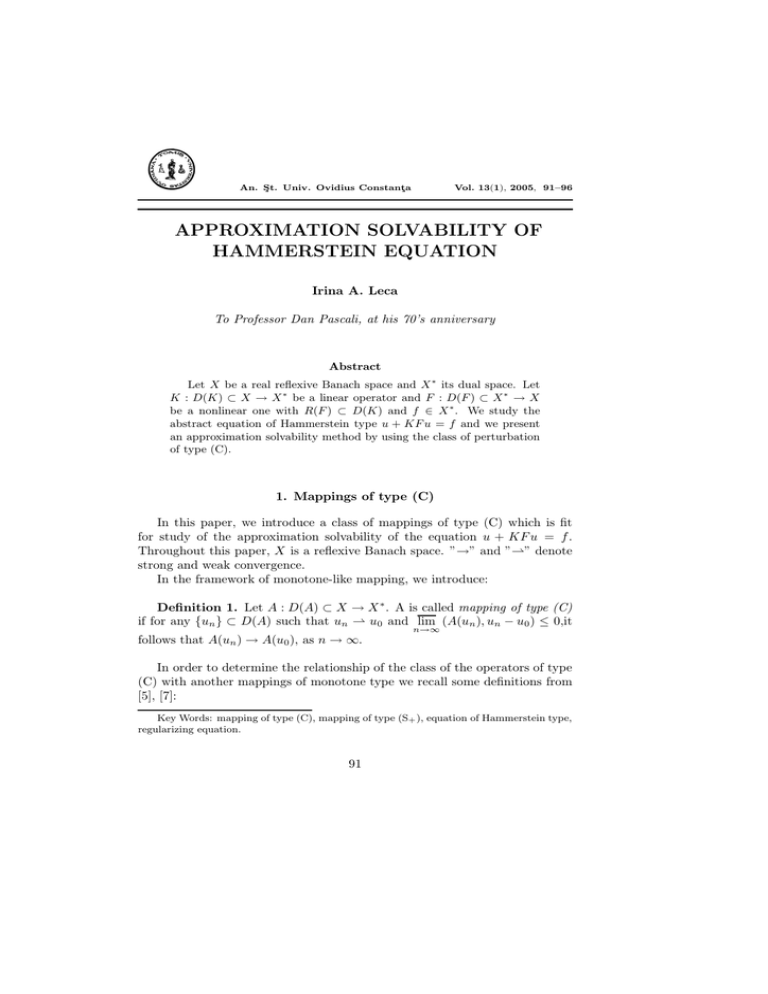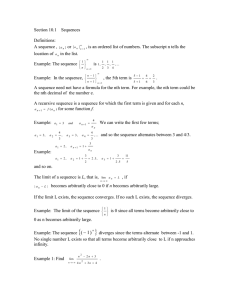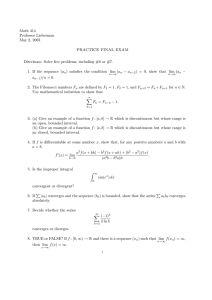APPROXIMATION SOLVABILITY OF HAMMERSTEIN EQUATION Irina A. Leca
advertisement

An. Şt. Univ. Ovidius Constanţa
Vol. 13(1), 2005, 91–96
APPROXIMATION SOLVABILITY OF
HAMMERSTEIN EQUATION
Irina A. Leca
To Professor Dan Pascali, at his 70’s anniversary
Abstract
Let X be a real reflexive Banach space and X ∗ its dual space. Let
K : D(K) ⊂ X → X ∗ be a linear operator and F : D(F ) ⊂ X ∗ → X
be a nonlinear one with R(F ) ⊂ D(K) and f ∈ X ∗ . We study the
abstract equation of Hammerstein type u + KF u = f and we present
an approximation solvability method by using the class of perturbation
of type (C).
1. Mappings of type (C)
In this paper, we introduce a class of mappings of type (C) which is fit
for study of the approximation solvability of the equation u + KF u = f .
Throughout this paper, X is a reflexive Banach space. ”→” and ”” denote
strong and weak convergence.
In the framework of monotone-like mapping, we introduce:
Definition 1. Let A : D(A) ⊂ X → X ∗ . A is called mapping of type (C)
if for any {un } ⊂ D(A) such that un u0 and lim (A(un ), un − u0 ) ≤ 0,it
follows that A(un ) → A(u0 ), as n → ∞.
n→∞
In order to determine the relationship of the class of the operators of type
(C) with another mappings of monotone type we recall some definitions from
[5], [7]:
Key Words: mapping of type (C), mapping of type (S+ ), equation of Hammerstein type,
regularizing equation.
91
Irina A. Leca
92
1) A is called mapping of type (S + ) if for any sequence {un } ⊂ D(A)
converging weakly to u0 in X, for which lim (A(un ) − A(u0 ), un − u0 ) ≤ 0 is
n→∞
in fact strongly convergent in X.
2) A is said to be quasi-monotone if each sequence {un } ⊂ D(A) with
un u0 in X, it follows that lim (A(un ), un − u0 ) ≥ 0.
n→∞
3) A is called angle-bounded with the constant a ≥ 0 if |(A(u), v) − (A(v), u)| ≤
1
1
2a (A(u), u) 2 · (A(v), v) 2 , for all u and v in D(A). The angle-boundedness of A
with a = 0 corresponds to the symmetry of A, i.e. (A(u), v) = (A(v), u) , ∀u, v ∈
D(A).
Proposition 2. If A : D(A) ⊂ X → X ∗ satisfies one of the following
conditions:
1.A is a continuous mapping of type (S + ),
2.A is a continuous angle-bounded mapping,
then A is a mapping of type (C).
To give some useful results we recall otherdefinitions from [5]:
2
2
1) The map J : X → X ∗ given by Ju = f ∈ X | (f, u) = u = f is called the normalized duality map of X.
Without loss of generality we suppose further that is locally uniformly
convex Banach space and J is single valued map.
2) Let A : D(A) ⊂ X → X ∗ . A is called mapping of type quasi-(S + ) if for
any ε > 0, A + εJ are the mappings of type (S+ ), where J : X → X ∗ is a
normalized duality map.
A basic relation between quasi-monotone operators and mappings of type
(S) due to Calvert and Webb ([5]) is:
Theorem 3. The demicontinuous operator A is quasi-monotone if and
only if A + εJ ∈ (S) for each ε > 0.
Proposition 4. Let Ω ⊂ X be a weakly closed set, {un } ⊂ Ω such that
un u0 in X and A : Ω → X ∗ be a mapping of type (C). Then A is a mapping
of type quasi-(S + ).
Proposition 5. Let Ω ⊂ X be a closed set, {un } ⊂ Ω, un u0 in X and
A : Ω → X ∗ be a bounded mapping of type (S + ). If
lim (A(un ) − A(um ), un − um ) ≤ 0,
m,n
then un → u0 , as n → ∞.
APPROXIMATION SOLVABILITY
93
Proposition 6. Let Ω ⊂ X be a weakly closed set, {un } ⊂ Ω and un u0
in X. If A : Ω → X ∗ is a bounded mapping of type (C) and
lim (A(un ) − A(um ), un − um ) ≤ 0,
m,n
then A(un ) → A(u0 ), as n → ∞.
Proposition 7. Let A : X → X ∗ be a hemicontinuous monotone mapping
of type (C) and J : X → X ∗ a normalized duality map. Then, for any ε > 0,
−1
A + εJ is invertible and (A + εJ)
: X ∗ → X is a bounded continuous
monotone mapping of type (S + ).
2. Approximation solvability of Hammerstein equation
∗
f ∈X .
Let K : D(K) ⊂ X → X ∗ , F : D(F ) ⊂ X ∗ → X, R(F ) ⊂ D(K) and
The equation
u + KF u = f
(1)
is called equation of Hammerstein type.
We consider the case of D(K) = X and D(F ) = X ∗ .
Definition 8. The equation
u + (K + λJ)(F + εJ ∗ )u = f
(2)
is called a regularizing equation of equation (1), where λ, ε are arbitrary
positive numbers, and J : X → X ∗ , J ∗ : X ∗ → X are normalized duality
maps.
Suppose that equation (2) is approximatively solvable, i.e. there is a sequence of monotonically increasing finite dimensional subspaces {Xn } ⊂ X,
in which the equations have a solutions un such that un → u, where u is a
solution of the original equation.
Let u + (K + λn J) (F + εm J ∗ ) u = f
(3)
with λn > 0, εm > 0, n, m ∈ N and λn → 0 (n → ∞), εm → 0 (m → ∞). If
the equation (3) has a solution uλn εm satisfying lim lim uλn εm = u and u is
m→∞n→∞
a solution of the equation (1), then the equation (1) is said to be regularizing
approximatively solvable.
Theorem 9.: Let K : X → X ∗ be continuous monotone mapping of type
(S + ) and K(0) = 0. Suppose N : X → X ∗ is coercive with respect to f ∈ X ∗ ,
i.e. there is r > 0 such that
(N u − f, u) > 0
for all u ∈ X, with u > r. Then the equation:
Irina A. Leca
94
N u + Ku = f
has at least a solution.
(4)
Theorem 10. Let K and N satisfy the condition of Theorem 9.
Let Γ = ({Xn } , {Xn∗ } ; {Pn } , {Qn }) be an injective approximation scheme
in the Petryshyn sense ([6]). Define an approximation equation of equation
(4) by
Nn u + K n u = Qn f
where Nn = Qn N Pn , Kn = Qn KPn and u ∈ Xn . Then
(i) ∀n ∈ N, ∃un ∈ Xn , such that Nn un + Kn un = Qn f
(ii) ∃ {unk } ⊂ {un } such that Pnk unk → u, k → ∞ and
u is a solution of equation (4).
Theorem 11. Let K : X → X ∗ be a continuous monotone mapping,
K(0) = 0, F : X ∗ → X a bounded and hemicontinuous monotone mapping of
type (C), f ∈ X ∗ and Γ = ({Xn } , {Xn∗ } ; {Pn } , {Qn }) an injective approximation scheme. Suppose that F is coercive, i.e.
(u − f, F u) > 0
(5)
for all u ∈ X ∗ , with u ≥ R > 0. Then, the equation of Hammerstein
type (1) is regularizing approximately solvable.
Proof. First, we prove that the equation (2) is approximatively solvable.
For any ε > 0 and λ > 0, we introduce the mappings Fε : X ∗ → X with
Fε = F + εJ ∗ and Kλ : X → X ∗ with Kλ = K + λJ. By the condition (5),
for u ≥ max (f , R) we have
(6)
(u − f, Fε u) > 0
Let v = Fε u. Since F is bounded, we have u → ∞ as v → ∞.
Conversely, since Fε is coercive, we have v → ∞ as u → ∞. Thus, the
condition (6) is equivalent to the following: ∃r > 0 such that for v ∈ X, v ≥
r, we have Fε−1 v − f, v > 0
By the Proposition 7, the assumption of the theorem and the above discussion, the corresponding conditions of Theorems 9 and 10 are satisfied. Hence,
the equation
(7)
Fε−1 v + Kλ v = f
is solvable in X. Furthermore, the equation (2) is also solvable in X ∗ .
Equation (7) is approximatively solvable. Its approximation equation is
(8)
Qn Fε−1 Pn v + Qn Kλ Pn v = Qn f , v ∈ Xn
By the definition of the mapping Pn , R(Pn ) is a closed subspace of X and
Pn : Xn → R(Pn ) is a bijection. Also, R(Qn ) is a closed subspace of Xn∗ ,
Qn : X ∗ → R(Qn ) ⊂ Xn∗ is a bijection.
APPROXIMATION SOLVABILITY
95
Note that the equation (8) is solvable.
Thus the equation u + Qn Kλ Fε Q−1
n u = Qn f has a solution in R(Qn ).
By Theorem 10 and the continuity of Fε−1 , there exists a subsequence
{unk } ⊂ {un } such that unk → u (k → ∞) and it can be proved easily that u
is a solution of the equation (2).
Secondly,we are to show that ∃λn > 0, with λn → 0 (n → ∞) and εm > 0,
with εm → 0 (m → ∞) such that solutions {uλn εm } of the equation (3) satisfy
lim lim uλn εm = u and u is a solution of the equation (1)
m→∞n→∞
Let vλε = Fε uλε . Then, ∀ε > 0 fixed, {vλε } are bounded with respect to
λ > 0. Otherwise, there would be a subsequence {vλn ε } such that vλn ε →
∞ (n → ∞). Thus, ∃N1 ∈ N, such that for n > N1 , vλn ε ≥ r. Since
Fε−1 vλn ε − f = − (K + λn J) vλn ε , we get a contradictory result:
0 < Fε−1 vλn ε − f, vλn ε = − ((K + λn J) vλn ε , vλn ε ) ≤ 0.
Since X is reflexive and {vλε } is bounded, there exists a subsequence {vλn ε }
such that vλn ε vε (n → ∞, λn → 0).
Let A1 = {vλn ε }. We choose arbitrarily vλn ε ∈ A1 , vλk ε ∈ A1 . Then
Fε−1 vλn ε + (K + λn J) vλn ε = f and Fε−1 vλk ε + (K + λk J) vλk ε = f . Thus
Fε−1 vλn ε − Fε−1 vλk ε + Kvλn ε − Kvλk ε + λn Jvλn ε − λk Jvλk ε = 0. Since A1 is
bounded and K is monotone, we have
lim Fε−1 vλn ε − Fε−1 vλk ε , vλn ε − vλk ε ≤ 0
n,k
By the Proposition 5, we have vλn ε → vε (n → ∞). In addition, by the
continuity of Fε−1 and K, vε satisfies the equation
Fε−1 v + Kv = f
This equation is equivalent to the following equation:
u + KFε u = f (9)
Let uε = Fε−1 vε . Then uε satisfies the equation (9) and uλn ε = Fε−1 vλn ε →
Fε−1 vε = uε (n → ∞).
Let {uε }ε>0 be a solution set of the equation (9). Similarly, we can prove
that {uε }ε>0 are bounded. By the reflexivity of X ∗ , then ∃ {uεm } such that
uεm u (m → ∞, εm → 0).
Let A2 = {uεm }. We consider arbitrarily uεm ∈ A2 , uεl ∈ A2 , then we
have uεm + KFεm uεm = f and uεl + KFεl uεl = f .
Thus uεm − uεl + KFεm uεm − KFεl uεl = 0.
By the boundedness of A2 and the monotonicity of K, we have
lim (F uεm − F uεl , uεm − uεl ) ≤ 0.
m,l
By Proposition 7, we have F uεm → F u (m → ∞). Finally, by the continuity of K and the equation (9), we have uεm → u (m → ∞) and u + KF u = f .
96
Irina A. Leca
Theorem 12. Let K : X → X ∗ be a bounded and continuous monotone mapping of type (C), K(0) = 0, F : X ∗ → X a bounded and continuous monotone mapping and f ∈ X ∗ . Suppose that ∃R > 0, such that
for u ∈ X ∗ , with u ≥ R, we have the condition (5). Suppose also that
Γ = ({Xn } , {Xn∗ } ; {Pn } , {Qn }) is an injective approximation scheme. Then,
the equation (1) is regularizing approximatively solvable.
Proposition 13. Let monotone mappings K : X → X ∗ and F : X ∗ → X
be such that the equation (1) has a solution and either K or F satisfies one of
the following conditions:
1. Either K or F is strictly monotone;
2. Either K or F is angle-bounded.
Then the solution of the equation (1) is unique.
References
[1] C.Chidume and H.Zegeye, Approximation of solutions of nonlinear equations of Hammerstein type in Hilbert space, Proceedings of the American Mathematical Society,
vol.133, (2005), 851-858.
[2] P.M.Fitzpatrick and W.V.Petryshyn, New existence theorems for nonlinear equations
of Hammerstein type, Trans. Am. Math. Soc., 160 (1971), 39-63.
[3] J.Mawhin and M.Willem, Compact perturbations of some nonlinear Hammerstein
equations, Riv. Mat. Univ. Parma, 4 (5), (1979), 199-213.
[4] M. Joshi and M.Ganesan, Approximate solvability of Hammerstein equation, Numer.
Funct. Anal. and Optimiz., 9(10) (1987), 1039-1058.
[5] D. Pascali, Topological Methods in Nonlinear Analysis, Courant Institute, New York,
1999.
[6] D.Pascali, An introduction to numerical functional analysis - Petryshyn’s A-proper
mapping theory, Courant Institute, New York, 2001.
[7] D.Pascali and S.Sburlan, Nonlinear mappings of monotone type, Editura Academiei,
Bucuresti, 1978.
[8] R.Precup, Methods in nonlinear integral equations, Kluwer Acad.Publ. Dordrecht,
2002.
[9] Y.Zhao and S.Song, Aproximation solvability of an equation of Hammerstein type,
Northeastern Math., 7 (3)(1991), 371-378.
Naval Academy ”Mircea cel Bătran”
Fulger Street no.1, Constanta
Romania
e-mail: irina leca@yahoo.com








